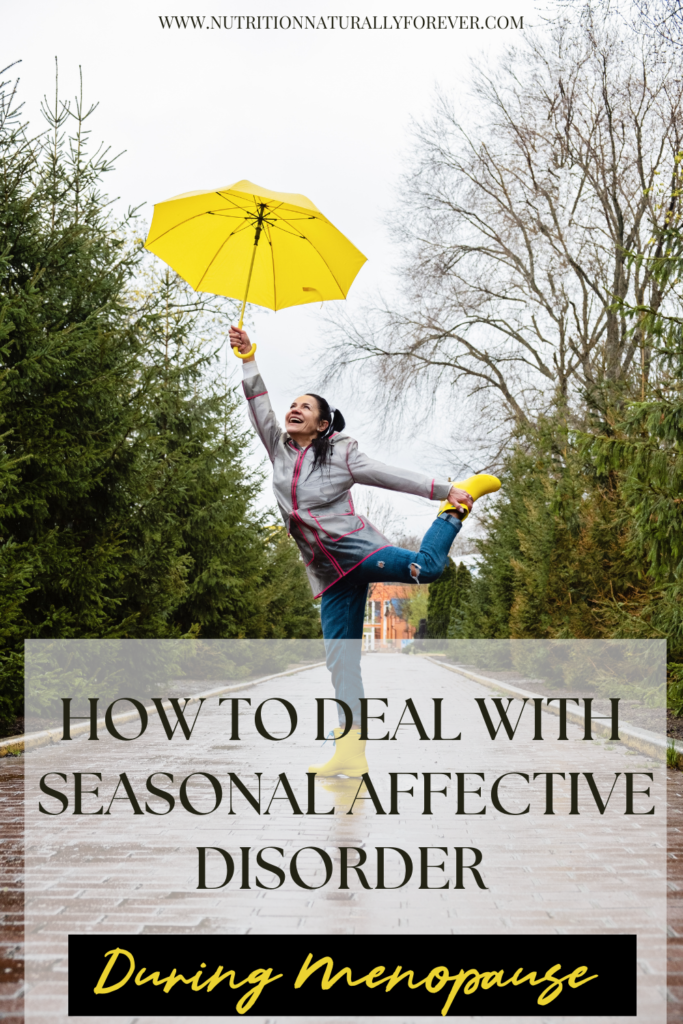
How to deal with seasonal affective disorder during menopause.
Menopause is a significant phase in a woman’s life, marked by hormonal changes that can have a profound impact on both physical and emotional well-being.
This weekend we say goodbye to British Summer Time, gaining an extra hour on Sunday however this will bring earlier evening darkness.
As we head to the Winter Solstice on Friday 22nd December the hours of daylight will continue to decrease.
While many of us are familiar with Seasonal Affective Disorder (SAD) striking during the autumn and winter months, it’s important to recognise that the intersection of SAD with menopause can create a unique set of challenges.
In this post, we will explore the connection between menopause and SAD and offer practical advice for managing these simultaneously.
Menopause and SAD: A Unique Challenge
Entering menopause, women experience hormonal fluctuations that can impact mood and exacerbate SAD symptoms.
Research indicates that SAD is four times more prevalent in women than in men, underscoring the need to effectively address both menopause and SAD.
Understanding the Symptoms:
The symptoms of Seasonal Affective Disorder include;
- Low energy
- Sleep disturbances
- Persistent feelings of sadness
- Difficulty concentrating
- Appetite and weight changes
- Apathy or a general feeling of hopelessness.
Menopausal women may experience these symptoms more intensely due to hormonal imbalances.
Understanding the physiological aspects can help you implement practices to alleviate your symptoms.
The Role of Hormones and Circadian Rhythm:
Every organ, system and cell in the body is controlled by hormones and neurotransmitters communicating with each other.
These are all affected by the circadian rhythm. Circadian means ‘about a day’.
The circadian rhythm is the 24-hour cycle of the body’s physical, mental and behavioural changes. This internal clock responds primarily to light and dark and is controlled by a small area in the middle of the brain called the pineal gland.
When it is dark the Pineal gland produces melatonin, which is the hormone responsible for sleep. When light hits the retina at the back of the eye an electrical pulse instructs the pineal gland to stop producing melatonin.
We can control the release of melatonin within our lifestyle, but how does the body make melatonin?
Serotonin is our happy hormone/neurotransmitter that is needed for the pineal gland to make serotonin.
If you are suffering from Seasonal Affective Disorder or low mood in general you probably lacking in serotonin.
We get serotonin from the food we eat.
Serotonin is made from Tryptophan which is an amino acid found in foods high in protein.
Another reason for menopausal women to make sure they are eating enough protein!
Managing Seasonal Affective Disorder and Menopause Naturally
A quick note on antidepressants. These are made from Selective Serotonin Reuptake Inhibitors (SSRIs). Essentially they work by stopping your body from releasing serotonin.
With the information in this post, you will be in the best position to support your body to produce enough of its own serotonin, here are some more tips;
Light Therapy For Seasonal Depression
Light therapy, or phototherapy, can be especially beneficial for women experiencing both menopause and SAD.
Exposure to bright light in the mornings can help regulate your circadian rhythm and alleviate mood-related symptoms.
Diet and Nutrition
As described above, protein is essential to produce serotonin which can be converted into melatonin. These nutrients don’t just work in isolation though.
Ensure you’re eating a well-balanced diet of protein, healthy fats and carbohydrates in the form of quality fibre. Focus on foods rich in essential nutrients, especially vitamin D, which is crucial for mood regulation. Omega-3 fatty acids can also be beneficial in managing mood.
Physical Activity
Regular physical activity releases endorphins, your body’s natural mood lifters. Even a daily walk or yoga session can do wonders for your emotional well-being.
Getting outside into fresh air and natural daylight will also support your internal circadian rhythm.
Mindfulness and Relaxation Techniques
Practising mindfulness, meditation, or relaxation exercises can help you manage stress and alleviate symptoms of both SAD and menopause.
Consult a Professional
Don’t hesitate to seek the guidance of a health professional or therapist who can provide coping strategies and emotional support tailored to your specific needs.
Don’t hesitate to book a 30-minute no-obligation chat with me to discover how I can support your journey through menopause.
Conclusion: Embracing Change
Menopause and Seasonal Affective Disorder may present unique challenges, but with the right approach, you can navigate them effectively.
By understanding the connection between menopause and seasonal affective disorder you can try implementing the strategies mentioned above to improve your emotional well-being.
You may also find these blog posts helpful; Solving Menopause Sleep Problems Naturally, and Hygge Your Life!
Every menopause journey, set of symptoms and individual lifestyle is unique. Discover my SHIFT System and understand how to work with your body through menopause and beyond to achieve your well-being goals.
Book a free, no-obligation call with me and come away feeling inspired and motivated to take control of your menopause health whether you choose to work with me or not.
Menopause is only the end of your reproductive years.
Step into the full power of your Wise Woman years with confidence so that you can embrace your post-menopause years with purpose.
I can’t wait to chat with you 💚
